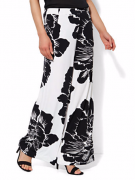Need To Know What’s Hip This Season? Google’s Got Your Back

While Americans looking for sartorial advice might not think to themselves that a bunch of computer programmers in Northern California would be their go-to source for advice on what is fashion’s cutting edge, it seems Google is not content to just answer all of America’s trivia questions and build out all of our robotic armies. Google, it seems, is now officially moving on to also telling us all how to dress.
Or at least to keeping us up to date on what all the cool kids are searching for this season.
Google has issued its first fashion trend report and is planning on issuing two of them annually as it moves to be a bigger player in both eCommerce and fashion. The report is drawn from user searches, and Google is even distinguishing between “sustained growth items” and “flash in the pan trends.”
So what does Google say is coo(g)l(e) this year?
Apparently the people are into tulle skirts, midi skirts, palazzo pants and jogger pants this season. What’s a palazzo pant? We didn’t know either, so there is a picture to the left.
are into tulle skirts, midi skirts, palazzo pants and jogger pants this season. What’s a palazzo pant? We didn’t know either, so there is a picture to the left.
Americans will be wearing those suspiciously pajama-esque pants this year instead of peplum dresses, which are in a period of sustained decline; skinny jeans, which are out this season, but Google thinks might make a comeback; and scarf vests, which were apparently a fad at some point, though not one we at PYMNTS could find an example of being worn out in public by an actual human being.
“We’re interested in being powerful digital consultants for our brands, not just somebody they can talk to about what ads they can buy online,” said Lisa Green, who heads Google’s fashion and luxury team, according to The New York Times. “They can say, ‘Google has identified this as a trend, and we have six weeks to get this out on the racks.’ ”
Google’s move on the fashion world is part of what appears to be a collective effort to become a defined shopping resource for consumers – no matter what they are shopping for. ECommerce has long been an area of interest for Google, which offers a shopping service that allows shoppers to compare prices among different vendors. Google also recently kicked off Shopping Express in some cities to make a move on the suddenly very hot area of grocery delivery.
But Google also faces stiff competition from commerce-centric marketplaces like Amazon and Alibaba, where consumers are somewhat more likely to do their product searching.
Google’s newest move is not exactly a new idea – IBM also tries to predict fashion trends by analyzing blogs, social media and news sites to gauge “social sentiment” on a variety of fashion items.
“People tend to make trend predictions based on a very limited number of observations, and that’s very hit and miss,” Trevor Davis, a consumer products expert who led the project at IBM, told The New York Times. “The ability to detect trends very early on before they really become noticeable, and to follow them, is invaluable.”
So can Google’s search data on fashion be the key that cracks the code? Maybe. A chink in the search paradigm is that it only tracks what users looked at, not what they bought, nor does it tell you if they ever intended to buy.
However, according to Ellen Sideri, founder of ESP Trendlab, the data’s value lies in its focus on what real people were interested in from across the country. Sideri was asked by Google to evaluate their database.
“The hardest thing to explain is that a trend doesn’t come from one place,” Sideri told The NY Times. “Every trend is multifaceted.”
For now, Google says it will share this database free to retailers and trend-followers in the hopes of winning partners and clout in the fashion arena. Google, fearing the ever present fox in the henhouse complaints from merchants, has also promised not to match up its search data with customer data from retailers to target ads at individuals.
